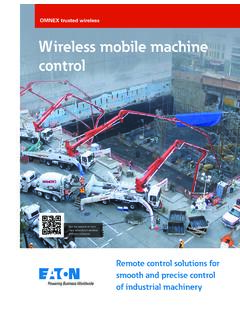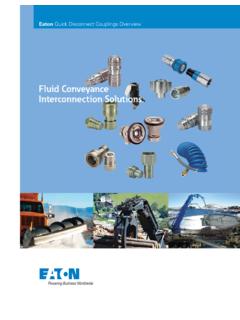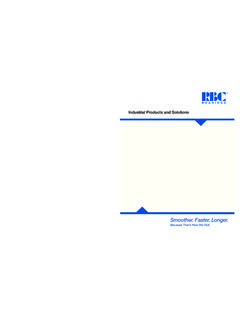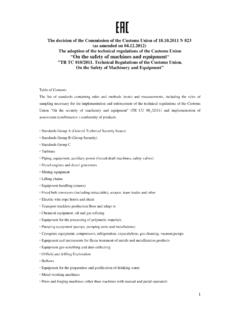Transcription of MTU S1600C Tier 4 EN - Rolls-Royce Power Systems
1 Background Article C&I / mining engines New MTU Series 1600 engines meet EPA tier 4 without exhaust gas aftertreatment Machines operating in the industrial sector are subject to very heavy demands, so it makes sense to keep those demands in mind when developing industrial engines. With its new Series 1600 engines for industrial applications, MTU will offer an off-highway solution that is powerful, cost-effective and easy to maintain. The Series 1600 engine family has been designed for use in Power generation, construction and industrial (C&I), agriculture, forestry, mining , oil and gas, and in rail applications. Launched in production in 2009, Series 1600 engines have proven their value in standby and continuous Power generation. From 2014, they will be offered for a large variety of off-highway industrial applications, such as agricultural vehicles, road construction machines, mining drills, and mid-sized dump trucks.
2 The Series 1600 covers Power outputs from 567kW to 730kW (760bhp to 979bhp), with a displacement volume of liters per cylinder. For the Power range below 567kW, MTU will be introducing its new Series 1000, 1100, 1300 and 1500 units beginning in 2014. Unlike these smaller engine models that are based on truck engines, MTU has developed Series 1600 as an autonomous off-highway engine family. Starting in January 2015, off-highway engines with rated outputs over 560kW will be subject to EPA tier 4 emissions standards of for oxides of nitrogen (NOX), for hydrocarbon (HC), for carbon monoxide (CO), and for particulate matter (PM). MTU s new Series 1600 engines are available in 10 and 12-cylinder V-configurations and are able to meet EPA tier 4 limits without exhaust gas aftertreatment. The technology package includes exhaust gas recirculation 2 (EGR), a high-pressure common rail fuel injection system and two-stage turbocharging, all of which enable combustion with very low NOX and PM.
3 Compact, cost-effective and powerful When used to Power standby gensets, these engines need high load acceptance capabilities. In mobile machinery applications, they must not only satisfy the valid emissions legislation, but also be specifically optimized to reduce the engine s space claim, weight and fuel consumption. Built according to a modular principle and equipped with a large number of interchangeable options, these powerful engines have been specially optimized for industrial applications. Their sturdy construction and the ability to cover a wide range of drive configurations from haul truck to forage harvester make them compact and easy to integrate into the machine. Even the cooling system for the machine s hydraulics can be integrated into the engine s cooling system. With few interface connections, such as those for coolant, electronics and air intake piping, makes Series 1600 installation quick and inexpensive.
4 The charge air coolers are directly mounted on the engine, eliminating the need for complex assembly in the machine. All of these features translate into low overhaul and operating costs for the benefit of the customer. In short, the engine can be integrated quickly and cheaply with a minimum number of connections and is easy to maintain. As with all MTU engine families, most components on the 10V version of the engine are identical with those on the 12V engine. That means that customers benefit from efficient spare parts logistics and a wide range of options for almost all applications. These options include various PTOs for additional drive configurations, air and air-conditioning compressors, and alternators. MTU also develops tailored solutions for customers with specific requirements. Key MTU technologies for state-of-the-art diesel combustion The capabilities of the new Series 1600 engines are the result of the MTU key technology package: 3 Cooled high-pressure exhaust gas recirculation (EGR) Two-stage turbocharging Common rail fuel injection ADEC (Advanced Diesel Engine Control) MTU's primary approach to achieving compliance with EPA tier 4 requirements is to reduce the pollutants generated by combustion.
5 In other words, MTU has focused on internal engine emissions reduction solutions. That means that the relevant key technologies have to be finely tuned. EGR, when combined with common rail injection and two-stage turbocharging, enables fuel combustion with very low NOX emissions. With EGR, some of the exhaust gas is cooled and fed back to the cylinder combustion chambers. The returned exhaust gas also reduces the combustion chamber temperature, thereby making fuel combustion cleaner, with much lower NOX emissions. This is important, especially in mining applications. MTU has also ensured that all EGR components are integrated into the engine in a very compact way so that the size of the engine and the exhaust piping are not significantly affected. Although EGR reduces NOX emissions, soot particulate emissions (PM) will increase if nothing else is done. With that in mind, MTU has continued to refine its fuel injection and turbocharging technologies.
6 Fuel injection takes place using an advanced electronic common rail system which allows the injection timing and the injection quality to be regulated per individual injector during any one combustion cycle. The fuel injection strategy can also be adjusted precisely according to the needs of any given operating situation. A high-pressure pump generates injection pressures of up to 2,200 bar, regardless of engine speed and the fuel injection quantity. Fuel is delivered to the injectors which inject it into the combustion chambers in the correct dose as a finely atomized spray. Soot particulate formation is kept at a very low level and fuel is utilized as efficiently as possible. 4 Exceptionally fast response Two-stage turbocharging provides the engine with combustion air to ensure maximum Power output while significantly reducing response time, even with sudden increases in speed. The two-stage turbocharging system of the new Series 1600 engine is equipped with low and high level turbochargers at each cylinder bank.
7 Turbocharger pressure is controlled by a waste gate, which is controlled electronically. Two-stage turbocharging involves compressing and then cooling the air at the first stage, and then compressing it even more and cooling it again at the second stage. That means that even at high altitudes where the air is thinner, the engine can deliver Power consistently at all speeds. This is an ideal solution for off-highway vehicles which need high torque, even at low speeds. The new ADEC the ultra-modern control system for diesel engines All engine and turbocharger functions are controlled, regulated and monitored centrally by the advanced diesel engine control unit (ADEC), developed by MTU. By fine-tuning high-pressure fuel injection to precisely suit the given load status, ADEC plays a major role in efficient, low-emission engine operation. For easy integration by OEMs, ADEC is equipped with an integrated SAE J1939 interface and several inputs and outputs, ready for customization.
8 Future developments MTU maintains its position as a leader in engine technologies by continually investing in research and development. Its Series 1600 engines are equipped to meet the demands of tighter emissions regulations, and industrial customers who Power their machinery using these engines stand to benefit from MTU s forward-looking engine concept. This means the Series 1600 will be able to meet the requirements of the future without complicated modifications even in the years well beyond 2015. - End - 5 Infobox technical data: 10V 1600 Rated Power kW 567 / 610 bhp 760 / 818 Rated Speed rpm 1,900 / 2,100 Peak Torque Nm 3,340 / 3,500 Bore/Stroke mm 122 / 150 Cylinder arrangement 90 V Displacement l cu in 1,068 Dimensions (L x H x W)
9 Mm 1,690 x 1,200 x 1,200 in x x Weight kg 1,940 lbs 4,277 Emissions compliance EPA tier 4 12V 1600 Rated Power kW 680/730 bhp 912/979 Rated Speed rpm 1,900/2,100 Peak Torque Nm 4,000/4,200 Bore/Stroke mm 122/150 Cylinder arrangement 90 V Displacement l cu in 1,282 Dimensions (L x H x W) mm 1,850 x 1,200 x 1200 in x x Weight kg 2,200 lbs 4,850 Emissions compliance EPA tier 4






